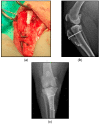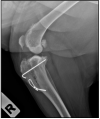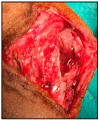Does PRGF Work? A Prospective Clinical Study in Dogs with A Novel Polylactic Acid Scaffold Injected with PRGF Using the Modified Maquet Technique
- PMID: 34438861
- PMCID: PMC8388684
- DOI: 10.3390/ani11082404
Does PRGF Work? A Prospective Clinical Study in Dogs with A Novel Polylactic Acid Scaffold Injected with PRGF Using the Modified Maquet Technique
Abstract
Tibial tuberosity advancement is a surgical technique to restore the dynamical stability in the knee by advancing the insertion of the patellar ligament, for which it is necessary to advance the tibial crest, being maintained in the desired position usually by a cage and metallic implants. The purpose of this study was to replace the cage with a polylactic acid biodegradable scaffold designed for each patient by 3D printing, inserting platelet-rich in growth factors (PRGF) to demonstrate its osteoinductive properties. To this end, we used the modified Maquet technique to reduce the amount of metal to a minimum. Fifty-three dogs finished the study. The control and PRGF groups did not present any statistically significant differences in terms of ossification degree (p > 0.001) but they demonstrated satisfactory ossification compared to previous publications, although in the PRGF group three of the scaffolds suffered complete reabsorption. The PRGF and control groups did not show any statistically significant differences in terms of lameness degree (p > 0.001). However, the PRGF group showed at the first control some analgesic and anti-inflammatory properties but they were not enough for reducing the functional recovery time in a significant way. The PRGF group did not show any complications or negative results associated with their use.
Keywords: 3D printing; MMT; PLA; PRGF; PRP; Plasma Rich in Growth Factors; TTA; dog; modified maquet technique; polylactic acid.
Conflict of interest statement
The authors declare no conflict of interest.
Figures
Similar articles
-
Incidence of Patellar Desmopathy in the Modified Maquet Technique with and without PRGF.Vet Sci. 2022 Apr 10;9(4):180. doi: 10.3390/vetsci9040180. Vet Sci. 2022. PMID: 35448678 Free PMC article.
-
Preliminary Clinical and Radiographic Evaluation of a Novel Resorbable Implant of Polylactic Acid (PLA) for Tibial Tuberosity Advancement (TTA) by Modified Maquet Technique (MMT).Animals (Basel). 2021 Apr 28;11(5):1271. doi: 10.3390/ani11051271. Animals (Basel). 2021. PMID: 33925099 Free PMC article.
-
Preliminary experience of a modified Maquet technique for repair of cranial cruciate ligament rupture in dogs.Vet Comp Orthop Traumatol. 2011;24(3):223-7. doi: 10.3415/VCOT-10-01-0012. Epub 2011 Feb 16. Vet Comp Orthop Traumatol. 2011. PMID: 21327289
-
The use of plasma rich in growth factors (PRGF) in guided tissue regeneration and guided bone regeneration. A review of histological, immunohistochemical, histomorphometrical, radiological and clinical results in humans.Ann Anat. 2020 Sep;231:151528. doi: 10.1016/j.aanat.2020.151528. Epub 2020 May 4. Ann Anat. 2020. PMID: 32376297 Review.
-
PRGF exerts more potent proliferative and anti-inflammatory effects than autologous serum on a cell culture inflammatory model.Exp Eye Res. 2016 Oct;151:115-21. doi: 10.1016/j.exer.2016.08.012. Epub 2016 Aug 25. Exp Eye Res. 2016. PMID: 27567559 Review.
Cited by
-
Tibial Tuberosity Advancement Techniques (TTAT): A Systematic Review.Animals (Basel). 2022 Aug 17;12(16):2114. doi: 10.3390/ani12162114. Animals (Basel). 2022. PMID: 36009702 Free PMC article. Review.
-
Incidence of Patellar Desmopathy in the Modified Maquet Technique with and without PRGF.Vet Sci. 2022 Apr 10;9(4):180. doi: 10.3390/vetsci9040180. Vet Sci. 2022. PMID: 35448678 Free PMC article.
-
Biodegradable Polymers in Veterinary Medicine-A Review.Molecules. 2024 Feb 17;29(4):883. doi: 10.3390/molecules29040883. Molecules. 2024. PMID: 38398635 Free PMC article. Review.
References
-
- Montavon P.M., Damur D.M. Advancement of the tibial tuberosity for the treatment of cranial cruciate deficient canine stifle; Proceedings of the 1st World Orthopeadic Veterinary Congress; ESVOT-VOS Munich, Germany. 5–8 September 2002; p. 152.
-
- Montavon P.M. Tibial tuberosity advancement (TTA) for the treatment of cranial cruciate disease in dogs: Evidences, technique and initial clinical results; Proceedings of the 12th ESVOT Congress; Munich, Germany. 10–12 September 2004; pp. 254–255.
-
- Lafaver S., Miller N.A., Stubbs W.P., Taylor R.A., Boudrieau R.J. Tibial tuberosity advancement for stabilization of the canine cranial cruciate ligament-deficient stifle joint: Surgical technique, early results, and complications in 101 dogs. Vet. Surg. 2007;36:573–586. doi: 10.1111/j.1532-950X.2007.00307.x. - DOI - PubMed
LinkOut - more resources
Full Text Sources
Research Materials





